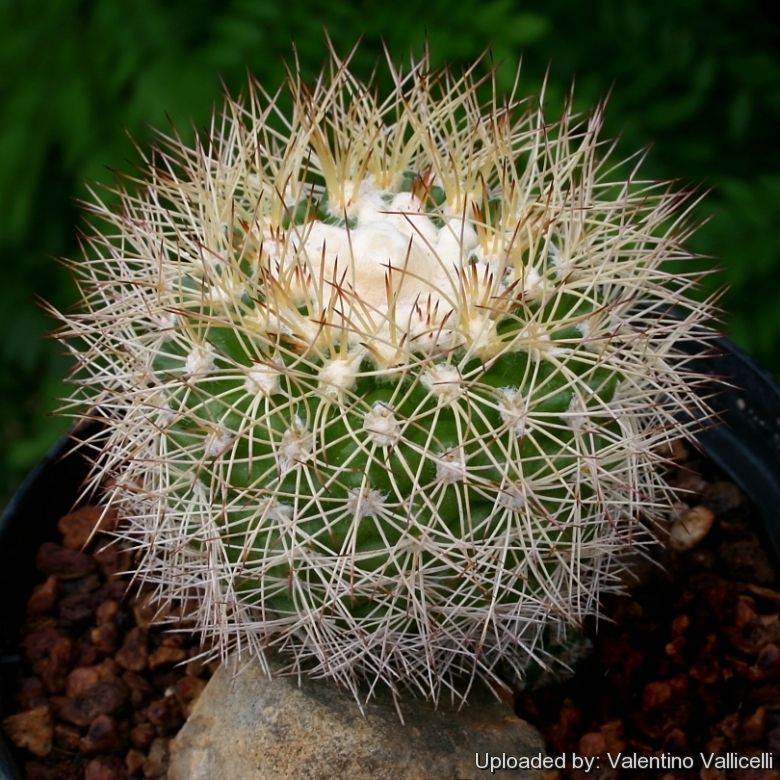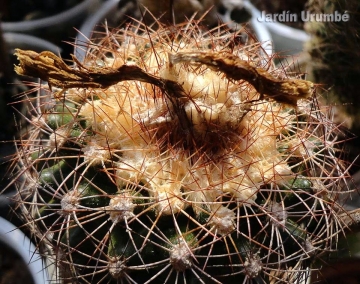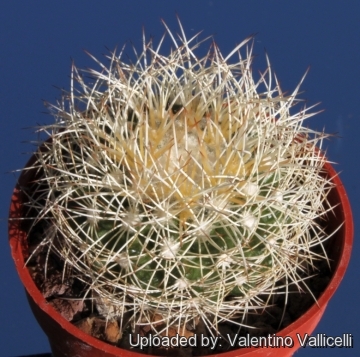
Discocactus zehntneri Photo by: Valentino Vallicelli
Origin and Habitat: Discocactus zehntneriSN|12925]]SN|12925]] is endemic to Southern Brazil, where it is found from central to northern Bahia into southeastern Piauí (extent of occurrence less than 20,000 km2). The subpopulations of Discocactus zehntneriSN|12925]]SN|12925]] in the lowland are found in small patches but those at high-altitude localities are locally abundant and common.
Altitude range: It grows at elevations ranging from 400 to 1200 metres above sea level.
Habitat: It is found between rocks growing together with grasses and shrubs. The main habitat for the lowland subpopulations consists of crystalline rock outcrops, while the high altitude subpopulations also grow between sandstone rocks on sand and gravel. This species rarely grows on iron and manganese ore (pedra canga). It is surrounded by caatinga or campo rupestre. The subpopulations in the lowland and in some high-altitude localities are declining, while other high-altitude subpopulations occur in a protected area and are stable. The main threat is quarrying of the rock, sand and iron ore on which this cactus thrives, and which is expected to lead to further population declines. Part of the species range was flooded as a consequence of the construction of the Sobradinho dam in the 1970s.
Synonyms:
See all synonyms of Discocactus zehntneri
Description: Discocactus zehntneriSN|12932]]SN|12925]] is a squat tiny little solitary plant. Two subspecies are recognized, the typical form and subsp. boomianus (Buining & Brederoo) N.P.Taylor & Zappi. Both subspecies - in culture - produce many offsets.
Stem: Dull-green 10-20 in diameter and 7-10 cm tall.
Cephalium: Up to 1 cm tall and -4 cm wide, at the apex of the plant, creamy-withe to light-brown with yellow to brownish bristles up to 2 cm..
Ribs: About 20, somewhat spiraled, forming nipple-like tubercles to 1 cm high.
Areoles: Oval, sunken, ca. 8 per ribs.
Radial spines: Interlacing, densely covering the plant, 10 to15 up to 1-2 cm long, pectinate, flexible spines creamy white or whitish-yellow with dark tips, becoming pale-brown to whitish, recurved backwards, sitting on the plant like spiders.
Central spines: None.
Flowers: White, scented, slender funnelform, 2 to 9 cm long. The position of the stigma is at the top of the stamens. Each flowering lasts only one night, but that night it produces many flowers.
Fruits: Club-shaped red 2,5 cm long. The plant produces seed-pods twice a year, when it flowers.
Chromosome number: 2n = 22
Remarks: This plant is part of the D. zehentneri complex which comprises several variable subordinates taxa, but not all are universally recognized.
The ssp. zehntneri Looks very much like Discocactus albispinusSN|12925]]SN|12932]]. They grow in the same area - Serra de Cabaluda- but D. zehntneri is smaller and has straighter spines than D. albispinus, also its shape is more globose.
Subspecies, varieties, forms and cultivars of plants belonging to the Discocactus zehntneri group
 Discocactus zehntneri Britton & Rose: Usually globose and completely covered in white thin, needle-like spines, the flower is about 3 cm long and the fruit are red (Origin: Sentocé)
Discocactus zehntneri Britton & Rose: Usually globose and completely covered in white thin, needle-like spines, the flower is about 3 cm long and the fruit are red (Origin: Sentocé) Discocactus zehntneri subs. albispinus (Buining & Bredero) P.J.Braun & Esteves: has larger flattend stems. Spines fewer, longer, white and more recurved. Distribution: South-east of Sento Sé in the Serra do San Francisco, Bahia.
Discocactus zehntneri subs. albispinus (Buining & Bredero) P.J.Braun & Esteves: has larger flattend stems. Spines fewer, longer, white and more recurved. Distribution: South-east of Sento Sé in the Serra do San Francisco, Bahia. Discocactus zehntneri subs. araneispinus (Buining & Bredero) P.J.Braun & Esteves: It has 10 to15 flexible, interlacing spines up to 1-2 cm long, that are pectinate, flexible, creamy white or whitish-yellow with dark tips, becoming pale-brown to whitish, recurved backwards, sitting on the plant like spiders.
Discocactus zehntneri subs. araneispinus (Buining & Bredero) P.J.Braun & Esteves: It has 10 to15 flexible, interlacing spines up to 1-2 cm long, that are pectinate, flexible, creamy white or whitish-yellow with dark tips, becoming pale-brown to whitish, recurved backwards, sitting on the plant like spiders. Discocactus zehntneri subs. boomianus (Buining & Bredero) N.P.Taylor & Zappi: Usually disk -shaped, with dark tipped yellowish spines, the flowers are up to 9 cm long. It has tuberous roots. (Origin: Morro do Chapéu municipality, Chapada Diamantina, Bahia)
Discocactus zehntneri subs. boomianus (Buining & Bredero) N.P.Taylor & Zappi: Usually disk -shaped, with dark tipped yellowish spines, the flowers are up to 9 cm long. It has tuberous roots. (Origin: Morro do Chapéu municipality, Chapada Diamantina, Bahia) Discocactus zehntneri subs. buenekeri (W.R.Abraham) P.J.Braun & Esteves: This species does share the complex commonality of tuberculate ribs and basal offsetting, but its white, club-shaped fruit does not fit with the dark red , much elongated and slender fruit of the other taxa.
Discocactus zehntneri subs. buenekeri (W.R.Abraham) P.J.Braun & Esteves: This species does share the complex commonality of tuberculate ribs and basal offsetting, but its white, club-shaped fruit does not fit with the dark red , much elongated and slender fruit of the other taxa. Discocactus zehntneri subs. horstiorum (P.J.Braun) P.J.Braun & Esteves: Slow growing form (Origin: near Minas do Mimosa, Moreno, Sierra do Espinahaco, Bahia )
Discocactus zehntneri subs. horstiorum (P.J.Braun) P.J.Braun & Esteves: Slow growing form (Origin: near Minas do Mimosa, Moreno, Sierra do Espinahaco, Bahia )
Bibliography: Major references and further lectures
1) Edward Anderson “The Cactus family” Timber Press, Incorporated, 2001
2) James Cullen, Sabina G. Knees, H. Suzanne Cubey "The European Garden Flora Flowering Plants: A Manual for the Identification of Plants Cultivated in Europe, Both Out-of-Doors and Under Glass" Cambridge University Press, 11/Aug/2011
3) David R Hunt; Nigel P Taylor; Graham Charles; International Cactaceae Systematics Group. "The New Cactus Lexicon" dh books, 2006
4) N. L. Britton, J. N. Rose “The Cactaceae. Descriptions and Illustrations of Plants of the Cactus Family.” Volume 4, The Carnegie Institution of Washington, Washington 1923
5) Machado, M., Braun, P., Taylor, N.P. & Zappi, D. 2013. Discocactus zehntneri. The IUCN Red List of Threatened Species. Version 2015.2. <www.iucnredlist.org>. Downloaded on 25 June 2015.
6) Juliana P. Castro, Luiz G.R. Souza, Lânia F. Alves, Ana E.B. Silva, Marcelo Guerra & Leonardo P. Felix. 1073 Marhold (ed.) “IAPT/IOPB chromosome data 15” TAXON 62 (5) • October 2013: 1073–1083
 Discocactus zehntneri Photo by: Prof. Ilham Alakbarov
Discocactus zehntneri Photo by: Prof. Ilham Alakbarov Discocactus zehntneri Photo by: Alexander Arzberger
Discocactus zehntneri Photo by: Alexander Arzberger Discocactus zehntneri Photo by: Cactus Art
Discocactus zehntneri Photo by: Cactus Art Discocactus zehntneri Photo by: Valentino Vallicelli
Discocactus zehntneri Photo by: Valentino Vallicelli Discocactus zehntneri Photo by: Valentino Vallicelli
Discocactus zehntneri Photo by: Valentino VallicelliSend a photo of this plant.The gallery now contains thousands of pictures, however it is possible to do even more. We are, of course, seeking photos of species not yet shown in the gallery but not only that, we are also looking for better pictures than those already present.
Read More... Cultivation and Propagation: It is one of the easiest species of the genus to grow, but even so it isn't a plants for beginners, in fact collectors consider the Discocactus to be rarities with requires skilful cultivation. It is rather difficult to grow and frost tender, it can’t stand cold, or even fairly cool temperatures and should be kept at above 15° C if grown on its own roots (8°C if grafted). Need full sun or afternoon shade. They are slow growing and very rot prone when kept on their own roots and though they can’t endure long stretches of total dryness, too much water will rot them, as their weak root systems tend to be inefficient at sucking up water from wet soil. They generally resent being repotted and can take a long time to establish. When grown to maturity, however, it possess an exotic look shared by no other cacti, and it generally attract a lot of attention.
Propagation: Seed or cuttings. Young seedlings are generally grafted on a low stock to keep the plant in a good shape.















